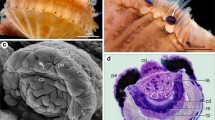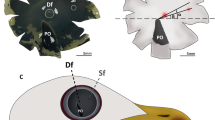Summary
Study of the eyes of the Boidae (Python reticulatus, Eryx johnii, Eryx conicus and Corallus enydris cooki) following the injection of Scribtol revealed that the structure of the spectacle capillary network was different from that in Elaphe longissima and the previously investigated Colubridae (Natrix natrix, Coluber najadum and Ahaetulla nasuta), probably due to evolution. While in the Colubridae the orientation of the stretched meshes found in the capillary network is normally vertical, in the Boidae the meshes of the network are typically less tightly stretched and the structure is more radiating, because of the position of the influx and efflux vessels.
The density of the meshes of the capillary network in the part of the spectacles not covered by ocularia is 11.4 in Python reticulatus, 9.2 in Eryx johnii, 6.3 in Eryx conicus, 1.8 (!) in Corallus endyris cooki, and 11.6 meshes/mm2 in Elaphe longissima.
When the quotient of the values for the coordinate difference (abscissa to ordinate value, abscissa=border of the supralabiala) ≧1 in the species investigated the average number of capillary meshes in the part of the spectacles not covered by ocularia represents in Python reticulatus 44.1% of all the meshes, 36.5% in Eryx johnii, 47.1% in Eryx conicus and 49.3% in Corallus endyris cooki, values significantly higher than the 20.3 % found in Elaphe longissima.
The location of the capillary meshes with a quotient ≧ 1 provides information as to whether one or more sectors of the spectacles possess a preferred mesh form. With the radiating structure of Python reticulatus this is not the case, however, in contrast to the similar structure found in Gekko gecko.
In the proximal part of the Aa. chorioidaea, that is, in the area where the optic nerve leaves the bulbus, there is a relatively wide luminal vessel network in Python reticulatus, this extends slightly in a ventral direction but more in temporal dorsal and nasal directions, and its meshes are twisted and often connected with the choriocapillaris. The vessel network of Corallus enydris cooki and Elaphe longissima was found to be similar, except that not as many connections were observed between the Aa. chorioideae and the Aa. ciliares communes nasalis or temporalis. In Eryx conicus the A. ciliaris communis temporalis has a dorsal branch shortly before it becomes the A. iridis temporalis, and later a long narrow ventral branch. The choriocapillaris of Corallus enydris cooki is drained dorsally by five or six veins, and ventrally by one V. chorioidea and a ring vessel surrounding the sheath of the optic nerve.
Zusammenfassung
Die mit Scribtol injizierten Augen der untersuchten Boidae (Python reticulatus, Eryx johnii, Eryx conicus und Corallus enydris cooki) zeigen im Vergleich zu den Augen aller bisher daraufhin geprüften Colubridae (Natrix natrix, Coluber najadugn, Ahaetulla nasuta und der für these Arbeit gesondert hinzugezogenen Elaphe longissima) eine unterschiedliche, möglicherweise stammesgeschichtlich bedingte Struktur ihres Brillenkapillarnetzes. Während bei den Colubridae bevorzugt eine vertikale Orientierung der langgestreckten Maschen ihres Kapillarnetzes gefunden wird, ist für die Boidae durch die Lage der zu- und abführenden Gefäße eine mehr radiäre Struktur bei weniger gestreckten Maschen kennzeichnend.
Die Dichte der Maschen des Kapillarnetzes in dem von den Ocularia freien Brillenteil liegt für Python reticulatus bei 11,4, für Eryx johnii bei 9,2, für Eryx conicus bei 6,3, für Corallus enydris cooki bei 1,8 (!) und für Elaphe longissima bei 11,6 Maschen/mm2.
Für die untersuchten Arten liegt in dem von den Ocularia freien Brillenteil die Durchschnittszahl der Kapillarmaschen mit einem Quotienten der Koordinatendifferenzwerte (Abszissen- zu Ordinatenwert, Abszisse=Grenze der Supralabialia) ≧ 1 und bezogen auf die Gesamtmaschenzahl für Python reticulatus bei 44,1 %, für Eryx johnii bei 36,5%, für Eryx conicus bei 47,1%, für Corallus enydris cooki bei 49,3%, dagegen fur Elaphe longissima bei 20,3%.
Die Lage dieser Kapillarmaschen mit einem Quotienten ≧1 gibt Auskunft darüber, ob ein oder mehrere Sektoren der Brille eine bevorzugte Maschenform aufweisen. Bei dem radiär strukturierten Brillenkapillarnetz von Python reticulatus ist dies im Gegensatz zu dem ähnlich angeordneten von Gekko gecko nicht der Fall.
Im proximalen Teil der Aa. chorioideae, d.h. um den Sehnervenaustritt liegt bei Python reticulatus vorwiegend temporal, dorsal und nasal, aber weniger ventral ein relativ großlumiges Gefäßnetz, dessen Maschen verwunden und mehrfach mit der Choriocapillaris verbunden Bind. Fine ähnliche, wenn auch nicht so starke Anastomosenbildung zwischen den Aa. chorioideae und den Aa. ciliares communes nasalis bzw. temporalis wird auch bei Corallus enydris cooki und Elaphe longiwima festgestellt. Die A. ciliaris communis temporalis gibt bei Eryx conicus kurz vor ihrem Übergang in die A. iridis temporalis einen dorsalen und danach einen ventralen, langen diinnen Zweig ab.
Die Choriocapillaris von Corallus enydris cooki wird dorsal von fünf bis sechs Abflüssen, ventral von einer V. chorioidea, neben einem an der Sehnervenscheide liegenden Ringgefäß drainiert.
Similar content being viewed by others
Literatur
Brundin, L.: Transantarctic relationships and their significance, as evidenced by chironomid midges. K. svenska Vetensk.-Akad. Handl. 11, 1–472 (1966).
Brundin, L.: Application of phylogenetic principles in systematics and evolutionary theory. Nobel Symposium 4, 473–495, Stockholm (1968).
Franz, V.: III. Höhere Sinnesorgane, 1. Vergleichende Anatomie des Wirbeltierauges. In: Bolk, L., Göppert, E., Kallius, E., Lubosch, W., Handbuch der vergleichenden Anatomic der Wirbeltiere, Bd. 2, 2. Hälfte, S. 989–1292. Berlin-Wien: Urban & Schwarzenberg 1934.
Heath, J. E., Northcutt, R. G., Barber, R. P.: Rotational optokinesis in reptiles and its bearing on pupillary shape. Z. vergl. Physiol. 62, 75–85 (1969).
Hennig, W.: Grundzuge einer Theorie der phylogenetischen Systematik. Berlin: Deutscher Zentralverlag 1950.
Johnson, G. L.: VII. Contributions to the comparative anatomy of the reptilian and the amphibian eye, chiefly based on ophthalmological examination. Phil. Trans. B 215, 315–353 (Plates 20–25) (1927).
Lüidicke, M.: Über die Kapillargebiete des Blutgefäßsystems im Kopf der Schlangen (Tropidonotus natrix und Zamenis dahli Fitz.). Z. Morph. Okol. Tiere 36, 401–445 (1940).
Lüdicke, M.: Handbuch der Zoologie, Serpentes (5), Bd. 7, 1. Hälfte, S. 1–128. Berlin: de Gruyter 1962.
Lüdicke, M.: Handbuch der Zoologie, Serpentes (5), Bd. 7, 1. Halfte, S. 129–258. Berlin: de Gruyter 1964.
Lüdicke, M.: Die Kapillarnetze der Brille, der Iris, des Glaskörpers und der Chorioidea des Auges vom Baumschnüffler Ahaetulla nasuta Lacépède 1789 (Serpentes, Colubridae). Z. Morph. Tiere 64, 373–390 (1969).
Lüdicke, M.: Über die Blutversorgung des Auges von Gekko gecko L. (Reptilia, Sauria). Z. Morph. Tiere 69, 23–47 (1971).
Mahendra, B. C.: Some remarks on the phylogeny of the ophidia. Anat. Anz. 86, 347–356 (1938).
Oehme, H.: Blutgefäße und Bindegewebe der Vogeliris. Morph. Jb. 113, 555–589 (1969).
Schlee, D.:DieRekonstruktionderPhylogenesemitHennig's Prinzip. Frankfurt a. M.: Kramer 1971.
Underwood, G.: The eye. In: Biology of the reptilia 2, Morphology B, Edit. Gans, C., Coedit. Parsons, Th. S., p. 1–93. London-New York: Acad. Press 1970.
Walls, G. L.: The vertebrate eye and its adaptive radiation. Bull. Cranbook Inst. Sci. 19, 1–785 (1942).
Author information
Authors and Affiliations
Rights and permissions
About this article
Cite this article
Lüdicke, M. Das system der blutkapillaren des auges, insbesondere der brille, von Python reticulatus Schneider 1801, Eryx johnii Russel 1801, Eryx conicus Schneider 1801 und Corallus enydris cooki Gray 1842 (Boidae). Z. Morph. Tiere 74, 193–219 (1973). https://doi.org/10.1007/BF00375784
Received:
Issue Date:
DOI: https://doi.org/10.1007/BF00375784




